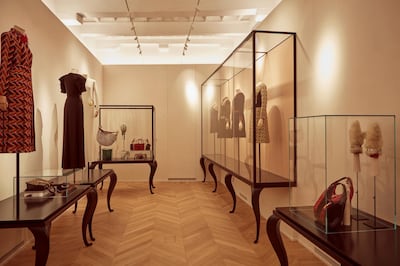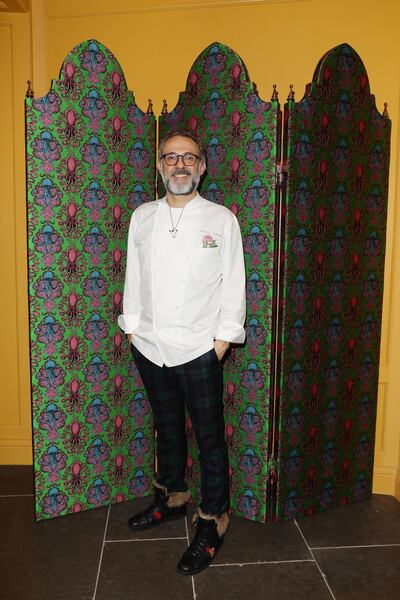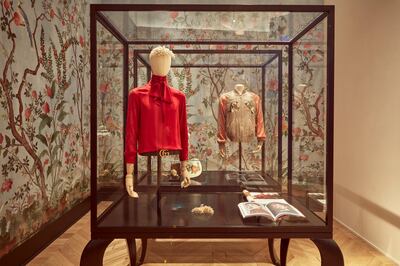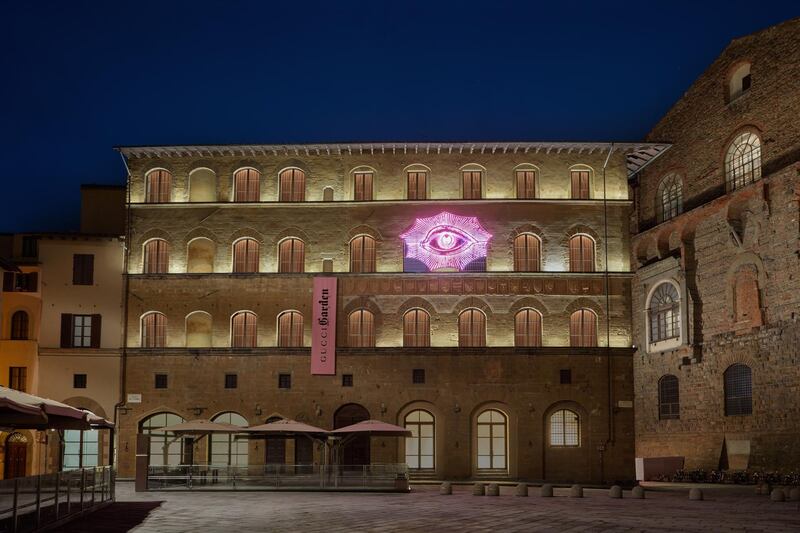It's no secret that Alessandro Michele is responsible for catapulting the ever-so-slightly dwindling star of Italian luxury label Gucci to stratospheric realms, but the current creative director is also very aware of the house's historic past. Accordingly, Michele was the driving force behind Gucci Garden, a multi-
dimensional concept launched last week inside the Palazzo della Mercanzia, which sits on the historic Piazza della Signoria in Florence – the birth city of the 97-year-old brand. The square was previously the site of the three-storey Gucci Museum.
“The past is very much part of the present at Gucci, which is perfectly in keeping with Alessandro’s idea of the brand, and indeed his attitude to Florence, Gucci’s home, which he sees as a city where history is still vibrantly alive,” says fashion critic Maria Luisa Frisa, who curated some of the Garden’s galleries and show spaces. For all of that, though, the first thing visitors will see is an enormous neon-pink eye set high against the 14th-century structure, a signboard that hints at the playfulness within.

Level one houses a busy boutique and gift shop, filled with Gucci fashion and other paraphernalia that are exclusive to the Garden, and come emblazoned with its logo and encased in specially created packaging. Tiger-face jumpers, silk bomber jackets, Gothic font T-shirts and printed footwear aside, the space also stocks stationery, crockery, candles, paperweights and chairs upholstered with the prints and motifs from recent collections. While basic tees start from Dh2,500, smaller items such as the brightly coloured, monogrammed notebooks cost as little as Dh85. Also for sale is a selection of niche magazines and books from the Antica Libreria Cascianelli in Rome.
For all its dizzying pops of colour and pattern, the two-room retail space has been designed in line with the original architecture of the palazzo, and is made up of hand-aged marble tiles, pillars with stones from the original facade, reproductions of mid-century busts, burnt yellow plaster walls and brass clothes hangers. Wares are displayed on furniture sourced from Florence’s antiques stores, and include a Tuscan table and carved stand from an old Italian pasticceria, period mirrors and old glass display cases, a wooden wardrobe polished down to its original floral decoration, an English country house cabinet and oriental rugs.
Also on this level is Gucci Osteria, the restaurant that marks the house’s first foray into fine dining. The 50-seater eatery will be headed by Massimo Bottura, the man behind the three-Michelin-starred Osteria Francescana in Modena, which was named the best restaurant in the world in 2016. A long-time friend of Gucci’s chief executive Marco Bizzarri, chef Bottura describes the venture as one where haute couture meets haute cuisine, which he says is “a recipe made in heaven”.

"The restaurant is a reminder that Florence has always been a centre of cultural exchange, particularly during the Renaissance." Accordingly, words from the 15th-century carnival song Canzona of the Seven Planets are etched in gold letters on the osteria's walls. The food is served on porcelain plates decorated with the brand's paisley print, while napkins are embroidered to resemble Gucci shirts.
On the menu are Bottura’s popular Italian dishes, including Parmigiano-Reggiano tortellini and mushroom risotto. However, possibly in a nod to his reported weakness for Shake Shack, the chef also offers hot dogs and burgers. Peruvian-style tostadas and Asian baos (stuffed steamed buns) are some of the other items on the menu, and have been inspired by the chef’s travels. Bottura, who was in the UAE in October, is also gearing up to open a restaurant at W Dubai on The Palm Jumeirah – an Italian eatery called Torno Subito – later this year.
_____________
Read more:
[ Predicting the hot trends in fashion for spring/summer 2018 ]
[ The land of make believe: Gucci opens new childrenswear store in Dubai ]
_____________
Levels two and three are where things get really interesting. Broken up into a series of rooms dedicated to the past collections and contemporary renditions of the brand, each space is a veritable artistic assault on the senses. The first gallery is named Guccification, and it’s covered from end to end with the many iterations of the brand’s double-G logo, which has transformed numerous times over the decades thanks to creatives such as artist Trevor “Gucci Ghost” Andrew and punk-inspired stylist Simon Foxton. The letters appear on their own or doodled within giant pineapples, pizza slices and funny faces. Also scrawled on these walls are the new ways of writing the brand name, including the self-parodying Guccy.
Next comes the Paraphernalia gallery, which is dedicated to the symbols and codes that the house is known for. These include the snaffle-bit loafers, the horsebit pattern, the red-green-red Web stripe and the bamboo cane, the treatment of which was patented by Gucci craftsmen in the 1940s. The third room, Cosmorama, harks back to Gucci's origins as a maker of leather goods and is dedicated to the sophisticated traveller – founder Guccio Gucci was a one-time porter at London's Savoy. The emblem of the hotel's bellboy is profiled in a video, while walls are adorned with luggage in myriad shapes and materials, acting as a comment on the changing face of travel. The second level of the Gucci Garden Galleria also has a 30-seat cinema, padded out in tongue-red velvet, which will screen experimental films. Currently on show is Zeus Machine/Phoenix, a short film by the Zapruder filmmakers group, the second episode in a film cycle dedicated to Hercules.
Floor three assigns two large rooms to Michele’s penchant for animals and plants. From butterflies and beetles to feline heads and oversized florals, the creative director has introduced a plethora of garden-inspired motifs since he took up the reins in 2015. Titled De Rerum Natura, the two galleries display the clothes, accessories, decor items and miscellaneous objects that have informed Gucci’s latest runways and collections, a style that the brand describes as “swinging between the natural and hyperartificial”.

The final showroom is called Ephemera and it’s filled with archival images and objets d’art that chronicle the history of the house since its conception in 1921, including old advertising campaigns, portraits of artisans and vintage couture. Ever the mystical artist, Michele has said of the multifaceted concept: “The [Gucci] garden is real, but it belongs above all to the mind, populated with plants and animals: like the snake, which slips in everywhere, and in a sense, symbolises a perpetual beginning and a perpetual return.” A statement that is at once bizarre, poetic and brimming with existential logic, and that perhaps perfectly encapsulates the hyperreality of the Gucci Garden.
The Gucci Garden Galleria and boutique are open from 10am to 7.30pm; entry to the galleries is €8 (Dh36), half of which will be donated to support restoration projects around Florence. Gucci Osteria is open from noon to 8.30pm; entry to the restaurant and the boutique is free of charge







